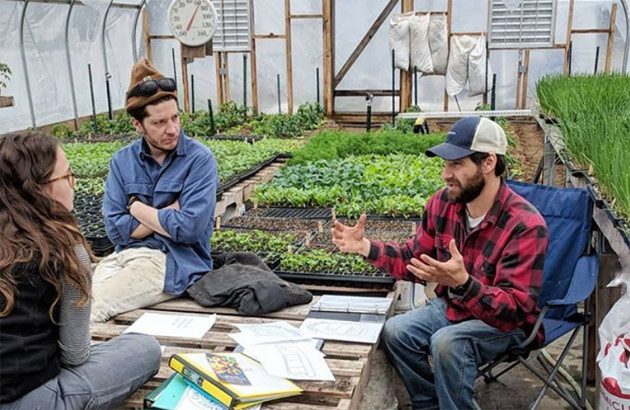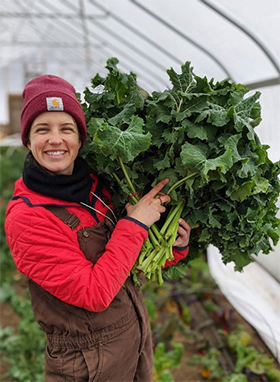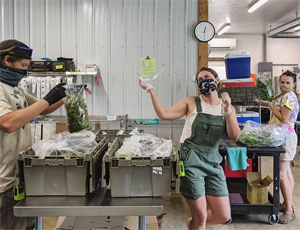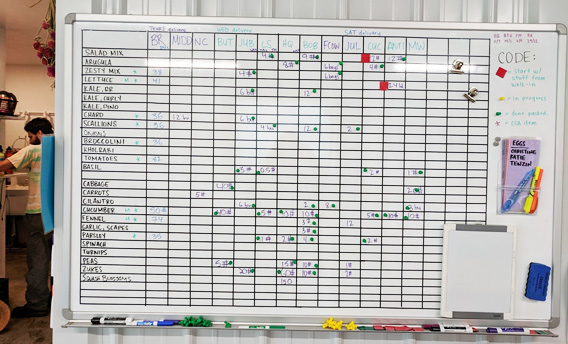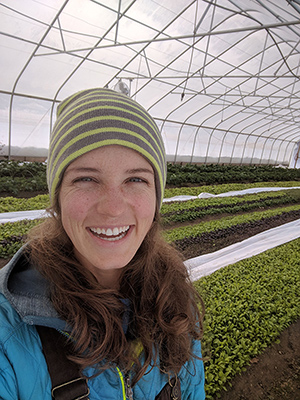- Planning & Plotting Your Market (or Backyard) Garden | An Intro to Johnny's Seed Quantity Calculators & Yield Charts
- Variety Selection Considerations | Tech Sheet (PDF)
- Gaining Efficiency on the Farm | Recommendations from 3 Experts in the Field
- Recordkeeping During the Busy Farming Season | by Taylor Mendell
- Video: Producer Cooperatives for Small-Scale Farmers | Johnny's Webinar Series
- Getting Started with Value-Added Foods & Farm Goods
- The Effect of Shorter Daylength on Winter Production
- Succession Planting Principles & Practices: Methods for Ensuring a Continuous Supply
- Recommended Crops for Succession Planting
- Succession-Planting Calculator (XLSX) | Johnny's Selected Seeds
- Johnny's Planting & Harvesting Programs
- Succession-Planting Interval Chart for Flowers
- Succession-Planting Interval Chart for Herbs
- Succession Planting Charts for Vegetables
- Video: Climate Adaptation for Vegetable & Flower Farmers | Johnny's Webinar Series
- Climate Adaptation for Vegetable & Flower Farmers | Johnny's Educational Webinar Resources
- 11 Things for Farming Elders — and their Beneficiaries — to Know About Medicaid Liens
Recordkeeping During the Busy Farming Season
by Taylor Mendell
Author, Educator, Co-Owner, Footprint Farm, Starksboro, Vermont
Recordkeeping During the Busy Farming Season
ABOUT THE AUTHOR
Taylor Mendell raises certified-organic vegetables on 1½ acres and produces eggs, pork, and other staples with her partner Jake at Footprint Farm in Starksboro, Vermont.
Before farming, Taylor studied public health in California, spent a year writing grants in Boston, and taught children about food, cooking, and goat milking. More recently Taylor founded Habit Farming, a forum for sharing resources, tutorials, and presentations to help small farmers develop habits that help them make a successful living while creating balance, health and wellness in their lives.
If you'd like to build a little more work/life balance into your day, visit HabitFarming to join and participate in Taylor's growing community, download planning sheets, learn ingenious and fun habithacks and farmhacks, watch videos, and gather abundant food for thought.
Note
Images used with permission. All rights reserved.
Numbers can help tell the story of your farming season, but which numbers are most important to pay attention to? Do you need to keep records for an external certifier? Are you hoping to find out how much money you're actually making on carrots? Or, do you know what records you need to take, but you usually end up with a stack of incomplete, incoherent scribbles that aren't really useful?
This article will help you decide what records to keep this season, and how to do it.
Why keep farming records?
There are many reasons to keep records on your farm. Some records are required by external entities (think organic certifiers or the IRS), while other records document information that can help move your business forward. Some even do both. The act of record keeping can also shed light onto inefficiencies in your farming systems, and give you the time and space to examine your systems more carefully.
What's required for farm recordkeeping?
If you are running a farming business, there are several business-related records that you are required to keep for the IRS, your state, and the Social Security Administration. These records will also be useful to help describe your business to a bank or other lending institution.
At the very least you should be keeping records on:
- sales and expenses (keep 7 years of history on file);
- documentation for physical assets like machinery or buildings (keep on file indefinitely);
- employee records like W4's and timesheets (keep on file for 4 years);
- any legal documents such as leases, LLC agreements, and the like (keep on file indefinitely).
All farms that are certified or audited by an external agency must keep specific records on file. These agencies might include State or USDA Organic or Animal Welfare Approved certifications, or they might be regulatory agencies that monitor farms for food safety, meat or dairy inspection, and more. Most agencies require that you document (and keep receipts for):
- your seeds;
- inputs such as potting soil and fertilizers;
- pest control materials.
In addition, you'll need to keep track of when you use each of those seeds and inputs, and in what amounts. Lastly, you will need to keep track of how much and when you harvest and to whom you sell. At our annual inspection we need to be able to show documentation for every life stage of a plant, from seed to sale.
What's important this season?
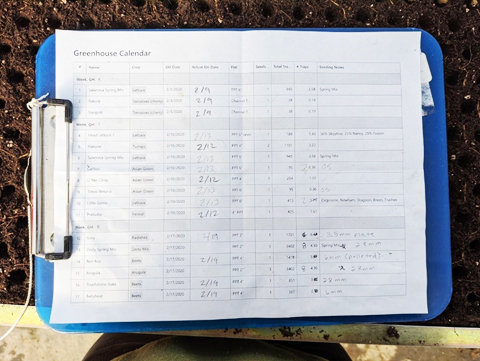
When we first started our farm we were overwhelmed by pressure to keep records on everything, from how many minutes we irrigated each bed of tomatoes to how many bunches of kale we sold at market. At the end of the season we were left with a pile of notes that were incomplete, messy, and not helpful in the least. I've since learned that I was looking for too much detail early on, and that what I needed was a broader look at how our fledgling farm was doing. Now that we have our feet under us, we are starting to drill down and look at those details more closely, but we're picking and choosing which data to track based on what we currently need to know about our farm.
These days we have systems to keep track of what we need to for our organic certification, and we have the capacity to track one to two other processes per season. Last year we scrutinized our high tunnel cucumber production in order to run a full cost of production (COP) study. The process helped us refine our cucumber growing systems, and the study's results allowed us to justify the expense of installing screening in our cucumber house this season. This year I will be tracking irrigation use in our high tunnels, as required by an NRCS grant. We also saw such value in knowing the cost of production of the cucumbers that we will be tracking COP data on one additional crop this season.
COVID contingency plan
Our 2020 farm plan included the usual planting and harvesting recordkeeping, and we were also planning an in-depth COP study on summer versus winter kale and mustard greens, our two biggest wintertime sellers. As COVID hit and our business changed radically, however, our recordkeeping priorities also shifted.
Although we have tracked labor time on a few particular crops, we have never asked employees to time themselves on processes outside of a particular COP study. This year we quickly saw that our new CSA box-packing process was cumbersome and frustrating, and immediately started to time how long it took, and to take note of each mistake made along the way. The next day we would address each item on the mistake list, redesign the system to address the mistakes, and re-time it.
After a few weeks of working to meet a new goal of just two mistakes in a two-hour packing period, we have made huge improvements in efficiency, and have a growing source of data to refer back to when we eventually decide whether to continue with our new system or to return to pre-COVID sales channels.
So, how do you decide what to keep track of?
We like to set annual goals, which helps define where we need to put our attention. These goals are usually set by what was most frustrating for us in the previous season. If you find yourself wondering whether something is worth the effort, or feel in your gut that something isn't going well, that could be a good spot to aim your focus. Try to think of a common frustration, decide what a better outcome might look like, then ask yourself what sort of number, date, or photographic evidence would help you achieve that outcome.
Here are some common starting points for record keeping based on how long you've been in the business.
- Beginning farms
For beginning farms (year 1–2), I recommend keeping the records that are required of you by external agencies, plus keep data on planting dates and harvest yields. Even if you have farmed for years at another site, data on planting dates will help you understand how varieties grow on your new land. We had farmed elsewhere, but realized after a couple of seasons that our new frost dates meant an available planting time about two weeks shorter than a town just 20 minutes to the north! - Once you have the basics down
Once you've learned your land's quirks, established markets, and settled on your production methods you can start to dive deeper. Ask yourself what information will help you understand your farm even better. Are you often feeling pressure from pests or disease? Try creating a calendar of pest arrival dates and intensity to help guide your pest prevention activities. Perhaps you are growing sweet corn in order to bring people to your farm store, but you have a suspicion that shoppers are just buying the corn and overlooking your more profitable crops. Try adding a point of sale (POS) system to see what exactly your shoppers are buying, to help you determine whether to reconsider growing corn. - Advanced farmer
Feel like you have the basics down pat? It might be time for a full-on cost of production (COP) study. This process tracks every step of production, including all time and expenses related to a specific crop. You may want to dive into a COP study if you have a suspicion that a particular crop is losing you money, or if you want to start pricing your products based on the actual cost to produce them rather than what you see other farmers charging. If you choose to try a COP this year, be sure to set up all record-keeping systems ahead of time. These require a lot of data to result in valuable information, and there is nothing worse than tracking data all season long, only to realize that you forgot to track one crucial aspect of the process.
How to keep records
Once you've decided which records to keep and why, it's time to create a system for capturing the most important data. Imagine yourself at the end of the season, opening your notebook, and having all the information that you need to answer your initial question. What does that notebook look like? What information is recorded in it? Who did the recording? Where did that notebook live during the season?
The key with forming any new habit, including record keeping, is to make it easy, enjoyable, and to have a good reason for incorporating that habit into your daily life. You already have that reason, which is that these numbers are going to help you evaluate how you meet this season's goals, or they might help you breeze through your organic inspection with flying colors. How are you going to make it easy and enjoyable to keep those records?
- First, I recommend deciding who on your team is going to be responsible for keeping these records. If it is someone other than yourself, set up a meeting with the person who will be responsible for creating this system with you.
- Next, ask if you are an online or a paper person. Someone who prefers paper may be uncomfortable entering data on an iPad, and someone who prefers apps may tend to lose paper or pencil.
- Then, make a physical recording system that works for you. The tools for taking these numbers down should be easily accessible and close to the location where the data are happening. For example, if you are tracking harvest time data, include a bright yellow Rite in the Rain notebook and attached pencil inside your harvest tool bin, inside your harvest binder, or on your harvest clipboard, so it's hard to miss. If you are prone to losing things, try keeping data on a dry-erase board then get in the habit of photographing the white board at the end of each day or week. If you don't want to re-enter data from a paper source, try using Google Forms and log your data on your phone, so everything goes directly into a Google Sheet for easy data manipulation.
- Some data-logging activities have a more sporadic cadence, and these can be scheduled onto a calendar, either on paper or in a digital format. Set reminders for later in the season.
Finally, it's equally important to create this system, buy necessary materials, and set reminders before you get too busy. (And if it turns out that recordkeeping would be more enjoyable with glittery unicorn pencils, then I'd encourage you to follow your instinct and get yourself some sparkle.)


